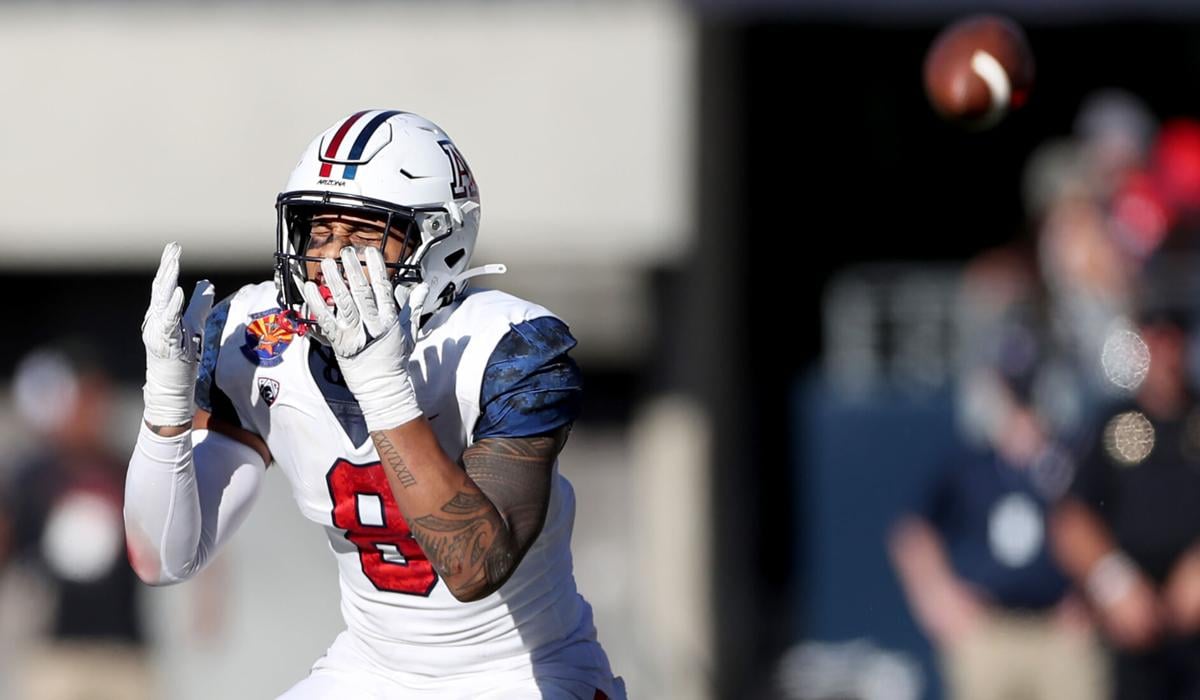Three minutes remained Saturday when field judge Jonathan Stubile blew his whistle and called a delay of game penalty on Utah, then squeezing a 31-29 lead at Arizona Stadium. Ute coach Kyle Whittingham blew his stack.
“What is that!?” he shouted at Stubile. “What is that!?”
I was standing 30 yards from Whittingham, near the Arizona goal line. I could hear him as if he were in my face.
“No way!” he yelled.
The tension on Utah’s sideline lasted for 58 minutes Saturday. It lasted until a facemask penalty on Arizona gave the Utes a first down at the 2-yard line and UA coach Jedd Fisch had exhausted his timeouts.
Ultimately, the better team won, 38-29. Utah beat Arizona because the Wildcats couldn’t sink a five-foot putt when they absolutely, positively had to sink a five-foot putt near the Utah goal line on three earlier possessions.
But the No. 24 Utes weren’t sweating only because it was near 90 degrees at the stadium. They were sweating because the Arizona of November 2021 has so improved from the Arizona teams of November 2020 and November 2019.
A year ago — heck, a month ago — those were impossible 40-foot putts, uphill, with a double break. So much has changed since the Wildcats were routed by San Diego State and stunned by NAU.
“They were physical, and not many teams match us physically,” Utah athletic director Mark Harlan told me as he walked into the winner’s locker room, already beginning to steel himself for next week’s Pac-12 game-of-the-year showdown against Oregon. “They were a tough out.”
Arizona’s performance went a step beyond beating a depleted Cal team a week earlier, and two steps beyond playing Oregon tough in September. It was the UA’s most encouraging performance since it beat Texas Tech, UCLA and Colorado early in the 2019 season.
Yet the Wildcats are the only Power 5 team with just one win this season, and words of praise from an opposing athletic director won’t make up for the 35,000 or so empty seats Saturday at Arizona Stadium. (The UA announced attendance at 32,008, but that didn’t account for at least 15,000 no-shows).
What did matter was that Arizona didn’t beat itself, as it did against UCLA and Colorado and so many other times in its 20-game losing streak. This time the Wildcats won the kicking game, pushed the passing game and lost because it couldn’t stop Utah’s power running ability, outgained in rushing yards 100 to 10 in the second half.
“Our guys matched them head-to-head on every single play,” said Fisch, who went on to use phrases “this is a learning curve” and “something really special is brewing.”
A year ago Sunday, the Wildcats began the COVID-19-delayed 2020 season, five forgettable games that led to the firing of coach Kevin Sumlin and the total overhaul of what had festered to the point that it had become the Pac-12’s most hapless football program.
If you would have told diehard UA football fans that in a year’s time the Wildcats would be competitive against Utah and Oregon — that Arizona established a new attitude and moved past its 70-7 loss in the Territorial Cup — even the most optimistic might’ve said “maybe you’re expecting too much, too soon.”
It’s not really the fans expecting too much too soon, as much as it is that Fisch hasn’t backed off his pledge to play winning football.
“Some of these ‘tough outs’ will become ‘tough wins’ for us,” he said Saturday. Check back next November, right?
My expectations of a competitive game Saturday were so modest — I thought the oddsmakers were correct with their 24-point Utah-favored spread — that I exited the press box in the second quarter and walked to the upper deck on the east side.
I had never seen Arizona Stadium as empty. Not even close — unless it was a week earlier against Cal. I wanted to document it for the record.
My goal was to count the number of fans in Sections 201-209. It looked do-able. It was do-able. There are 40 rows in all nine of those sections, with 30 seats per row. That’s roughly 11,000 seats.
In the middle of the second quarter there were 483 people in those 11,000 seats. I even counted those huddled against the retaining wall, in the shade of Section 209 — the southern-most section of the upper deck. There were 27 shade-hugging fans in section 209. Only 17 sat in the sunlight.
That’s out of 1,200 available seats.
Maybe someday when Arizona gets back to contention in the Pac-12, back to the Top 25, with more than 50,000 in the stands, someone can say: “I remember the day when they only had 44 people in section 209.”
Or maybe not. That’s not a statistic to remember.
I could’ve counted those in the near-vacant Zona Zoo as well, but by then the Utes were on the ropes and I was back in the AC of the press box, almost disbelieving what I was seeing: Arizona had a realistic chance to win.
Once Whittingham got into the Utes’ locker room, he had gained a perspective on the club’s sixth win in seven games, an uptick that began when the Utes “won ugly” after trailing Washington State 13-10 in the fourth quarter.
“That’s what you call winning ugly, you have to do that once in a while,” Whittingham said. “If you’re a good team, you’ll do that; you’ll win ugly ones.”
Someday, perhaps later this month in Tempe, Arizona will win an ugly one, too. And if not then, at least it no longer seems like an impossible dream.





